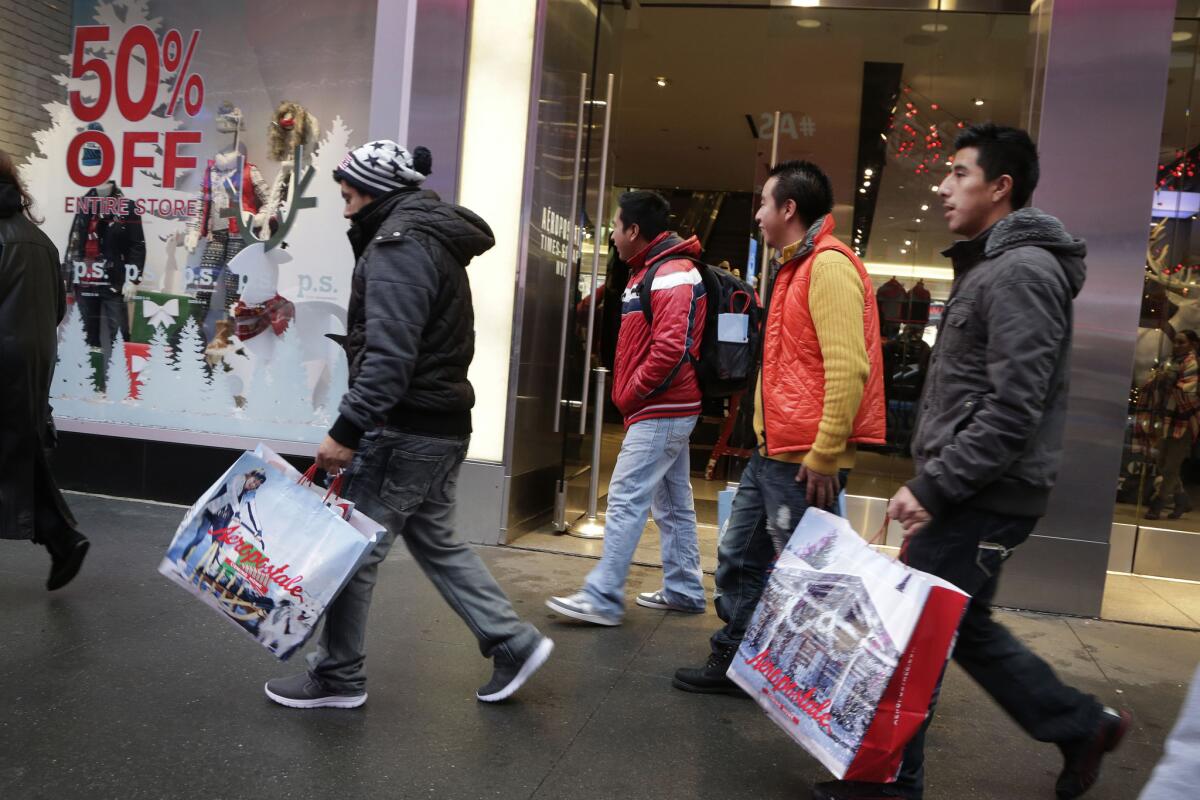Cautious consumers hold back on spending in December as concerns rise about U.S. economy

Shoppers carry their bags as they leave the Aeropostale clothing store in New York’s Times Square on Dec. 2, 2015.
Reporting from Washington — Consumers ended last year by cautiously holding on to their cash, spending slightly less in December even as their incomes rose for the ninth consecutive month, the Commerce Department said Monday.
Consumer spending declined by $700 million, or less than 0.1%, to $12.5 trillion. The figure was down from an upwardly revised 0.5% increase in November.
See the most-read stories this hour >>
Personal income rose 0.3% in December, the same as in the previous month.
Consumers opted to save more of their extra earnings. The share of disposable income that was saved increased to 5.5% in December, from 5.3% the previous month, matching a three-year high.
“Consumer spending ended the fourth quarter on a low note,” said Chris G. Christopher Jr., director of consumer economics at IHS Global Insight.
“In November, consumers came out swinging -- they saved less and spent more,” he said. “In December, consumers took a breather and consumer spending was flat.”
Christopher said she expected spending to pick up in the first quarter of this year.
Consumer spending accounts for about two-thirds of U.S. economic activity, so saving results in slower growth.
There also were mixed signs Monday for the higher-paying construction and manufacturing sectors as a survey of leading economists showed the risk of a U.S. recession rising.
Construction spending rose slightly in December, increasing 0.1% from the previous month, the Commerce Department said. The growth was weak, but an improvement over a 0.6% decline in November.
In addition, a private report indicated that the U.S. manufacturing sector contracted for a fourth consecutive month in January.
The Institute of Supply Management’s purchasing managers index ticked up slightly to a still-weak 48.2, from 48 the previous month. A reading below 50 indicates that the sector is contracting.
Manufacturers have been hurt by the strong dollar, which increases the costs of U.S. goods abroad. And low oil prices have hurt energy production companies.
Overall economic growth slowed sharply in the last three months of 2015, the Commerce Department said last week.
The U.S. economy expanded at just a 0.7% annual pace in the fourth quarter, largely because of declining exports and business investment.
Consumer spending for the quarter increased 2.2%, down from 3% in the previous quarter.
See more of our top stories on Facebook >>
Federal Reserve policymakers are watching economic data closely to determine if they should raise a key interest rate at their March meeting. The Fed nudged up the rate in December for the first time in nearly a decade in a vote of confidence for the recovery from the Great Recession.
Fed Vice Chairman Stanley Fischer said Monday that “increased concern about the global outlook,” including the effects of economic reforms in China and low oil prices, triggered the recent financial market volatility and led the Fed to hold off on another rate hike.
“If these developments lead to a persistent tightening of financial conditions, they could signal a slowing in the global economy that could affect growth and inflation in the United States,” he said in a speech to the Council on Foreign Relations in New York. “But we have seen similar periods of volatility in recent years that have left little permanent imprint on the economy.”
He said Fed policymakers didn’t know at this point if they would raise the central bank’s benchmark short-term interest rate at their next meeting in March.
“The world is an uncertain place, and all monetary policymakers can really be sure of is that what will happen is often different from what we currently expect,” he said.
A key concern of Fed officials is stubbornly low inflation, and Monday’s report showed the problem worsened in December.
The price index for personal consumption expenditures -- the Fed’s preferred inflation measure -- declined 0.1% after rising 0.1% the previous month.
The December drop was the first since September.
Prices rose just 0.6% last year, well below the Fed’s target of 2%. Still, that was an improvement over the 0.4% increase for the 12 months ended Nov. 30.
Sharply lower oil prices were a key factor. The energy price index declined 13.6% last year. Food prices dropped 0.3%.
Excluding often volatile energy and food costs, so-called core inflation was 1.4% last year.
Slowing global growth and declining oil prices have roiled financial markets this year and led to concerns that the U.S. economy would be hurt.
Top global economists said the risk of a recession in the U.S. this year has increased to 20%, according to results of a Financial Times survey released on Sunday.
In December, respondents said there was just a 15% chance of a U.S. recession in the next two years.
Follow @JimPuzzanghera on Twitter
ALSO
Southern California casinos going all in to lure millennials
Big U.S. banks will be rolling out ATMs that take smartphones, not cards
Super Bowl 50 to draw an estimated $4.2 billion in bets — most of them illegal
More to Read
Inside the business of entertainment
The Wide Shot brings you news, analysis and insights on everything from streaming wars to production — and what it all means for the future.
You may occasionally receive promotional content from the Los Angeles Times.











